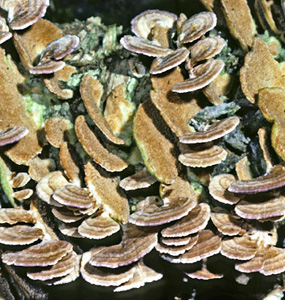Trichaptum biforme

Image Courtesy of Henry H. Mashburn
| Click to Enlarge |
| Click For Image Gallery |
|
Group of Fungi: Polypores Family: Polyporaceae Latin Name: Trichaptum biforme (Fr.) Ryvarden Common Name: Violet Toothed Polypore Description: Semicircular shelf-like or hoof-shaped structure, commonly occurring in overlapping clusters, these often extensive; cap 3/8–2 1/2 in (1–6.5 cm) across and 1/8–1/4 in (0.3–0.5 cm) thick, upper surface light gray to pale buff, hairy, concentrically zoned with a purple margin; spore-bearing surface violet to purple when young but fading in age and becoming cream colored or buff, pores moderately large, at first angular but splitting to give rise to spine-like projections; stalk lacking; spores white in mass. Biological Role: Decomposer of wood. Habitat: On fallen logs and stumps of broadleaf trees or more rarely conifers. Geographical Distribution: Widely distributed throughout North America. Comments: Trichaptum biforme, one of the more common and widely distributed polypores, has been recorded from many different species of trees. The bright violet to purple color of the spore-bearing surface in fresh specimens of this fungus is a distinctive feature not shared with any other species likely to be encountered in NCR parks. |
| Go Back |